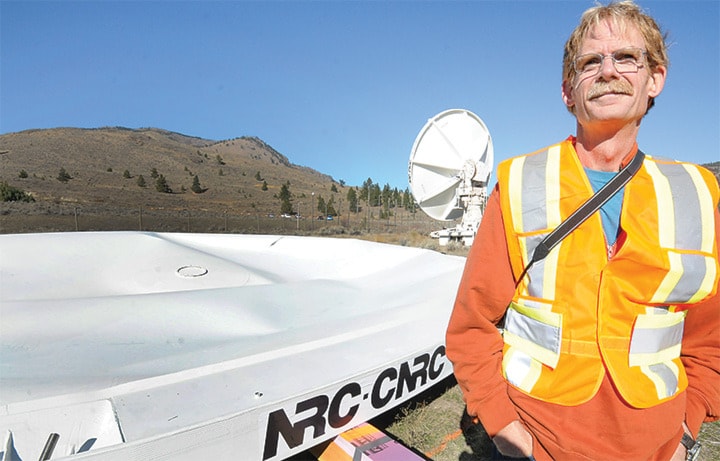The “spin machine” kicked into high gear following a well-publicized mishap last year at the Dominion Radio Astrophysical Observatory near Penticton.
A helicopter was transporting a 15-metre carbon fibre dish to the site on Oct. 17, 2013, when a wind gust caught the $300,000 scientific instrument, which was dented after it bounced around on its tethers.
Members of the local media, plus a crew from Discovery Channel, were on hand to witness and record the event, prompting officials from the observatory and its parent agency, National Research Council Canada, to scramble to place the incident in the best possible light while keeping the site open to reporters.
An hour after the mishap, NRC chief media relations officer Charles Drouin emailed his bosses to explain that observatory director Sean Dougherty would “make a statement to the effect that these things happen in science and that we are assessing the damage.
“Media will then be allowed to get closer to the dish. This is an intent to favour the best coverage possible at this point by showcasing the technology itself,” Drouin wrote in the email, a copy of which was obtained by the Western News through an access to information request.
Two weeks later, project team leader Gary Hovey told colleagues the dish had been popped back into shape and repairs were proceeding as planned, and suggested reaching out to the media with the good-news story.
That story idea was quickly shut down due to an apparent fear it would remind the public about the original mishap.
“The spin machine has been firing pretty much every day since the lift,” Eric Chisholm, an NRC project manager, wrote in an email to Hovey and others.
“At this point, sending anything to the media will likely see them, for context, re-broadcast the lift portion which regardless of (how) well managed things have been, reminds people that this didn’t go to plan.”
Chisholm also suggested news stories would get bogged down with technical details, and recommended the scientists wait until the dish goes online before inviting media to revisit the story.
That invitation went out earlier this month to reporters, who watched last week as the dish was lifted without incident onto its permanent base.
Drouin said in a statement provided to the Western News that the project team “demonstrated the utmost ingenuity, optimism and flexibility when the dish was damaged,” and it was his job to help their talents shine through.
“From a communications standpoint, my goal was to ensure that the media who were present would capture and highlight this resilience,” he said.
“NRC prides itself in maintaining a high level of excellence in all our endeavours, and we strive to portray and reinforce this image to our stakeholders in all situations.”
Alex Atamanenko, the long-time New Democratic Party MP for Southern Interior, said the intense interest in media management is the new normal for federal agencies.
“Scientists in general are not allowed to speak out as much as they have in the past. Does that have something to do with this? I don’t know,” he said.
“It seems now there’s a lot more controls placed by the Prime Minister’s Office on them, so it’s very possible that what you’ve seen here is a reflection of this new policy.”
The documents pegged the cost to fix the dish at $85,000. That included $10,000 for heating fuel used to warm a temporary structure erected around the device during repairs, which were accomplished by using large airbags from a commercial vehicle towing to snap the dish back into shape and then filling cracks with fresh carbon fibre.
The dish is a prototype designed for the Square Kilometre Array, a multinational effort to build a radio telescope with multiple collectors totalling one kilometre in surface area.
